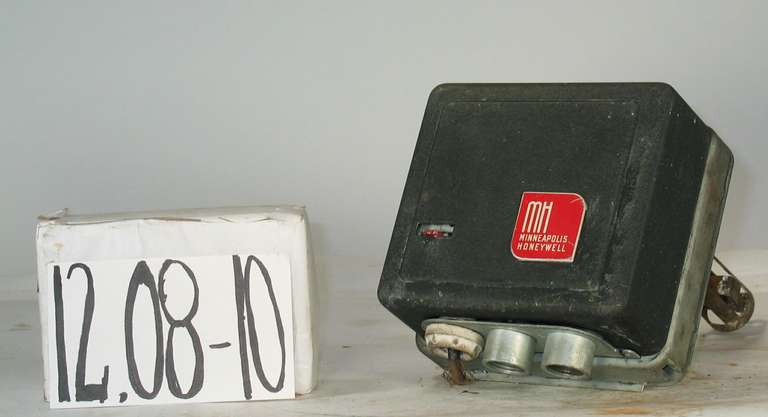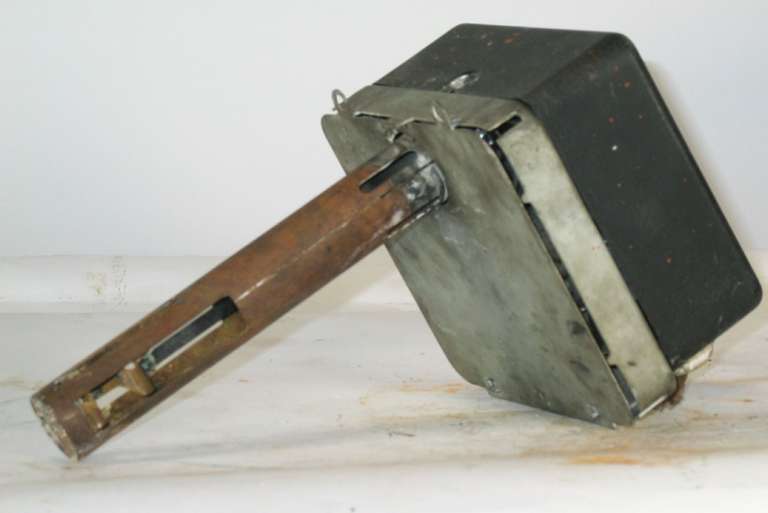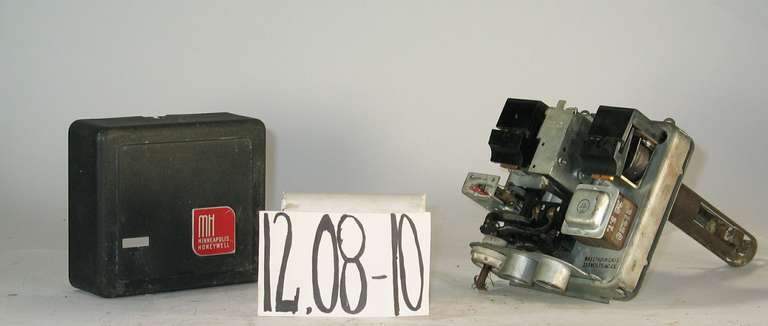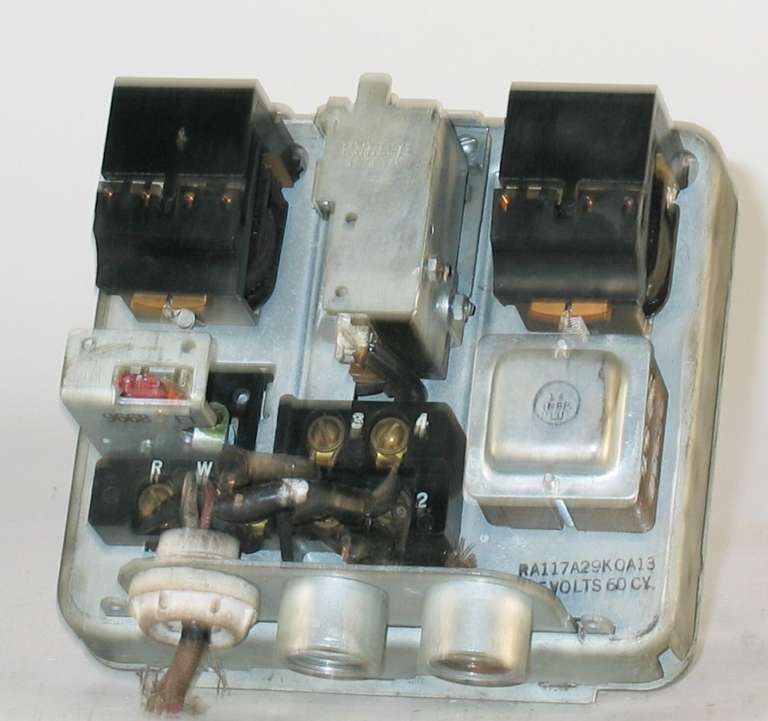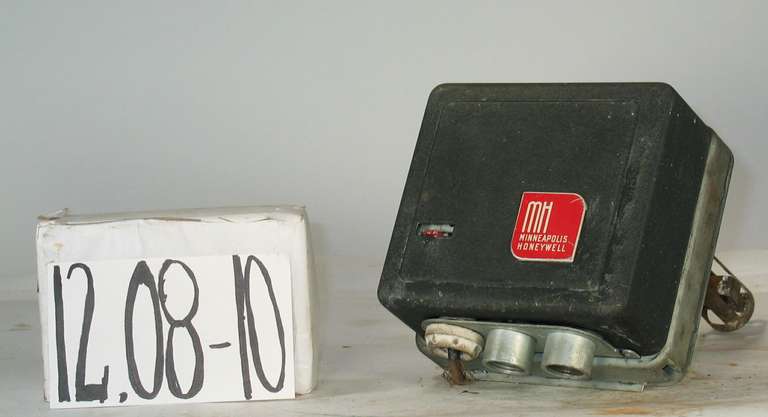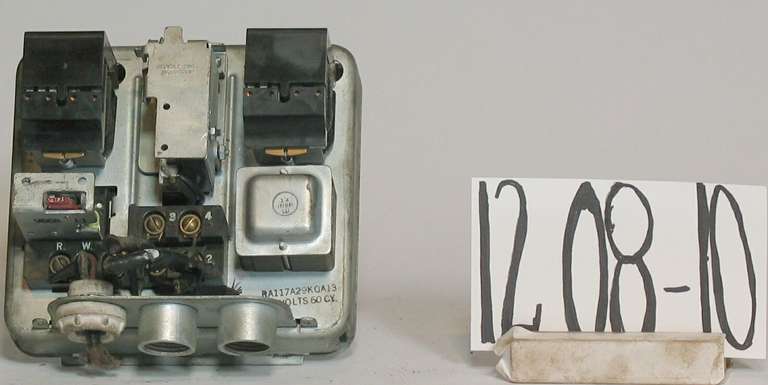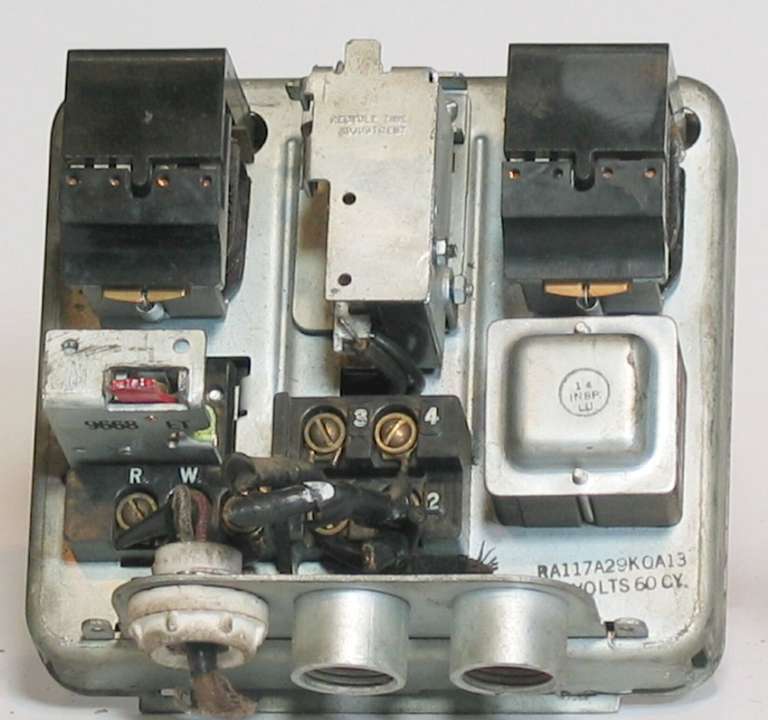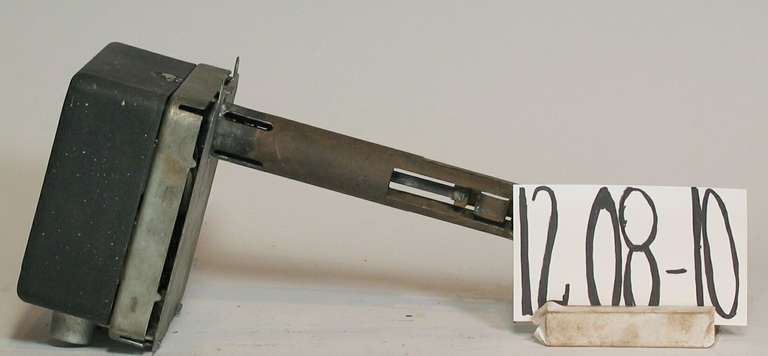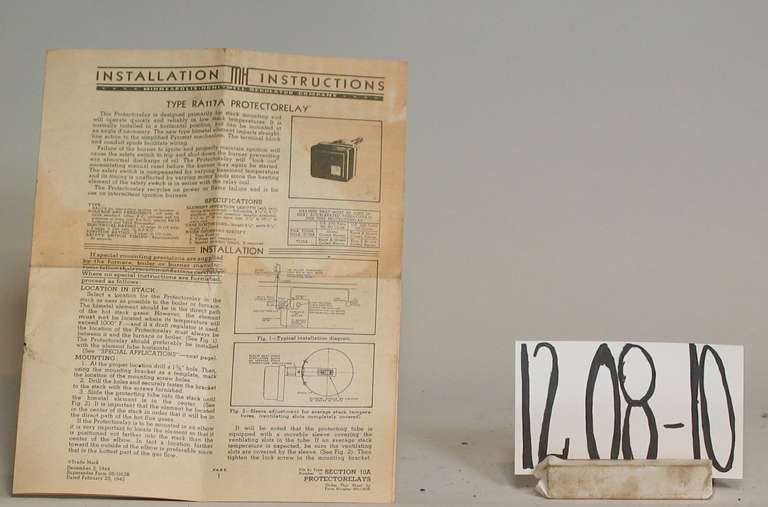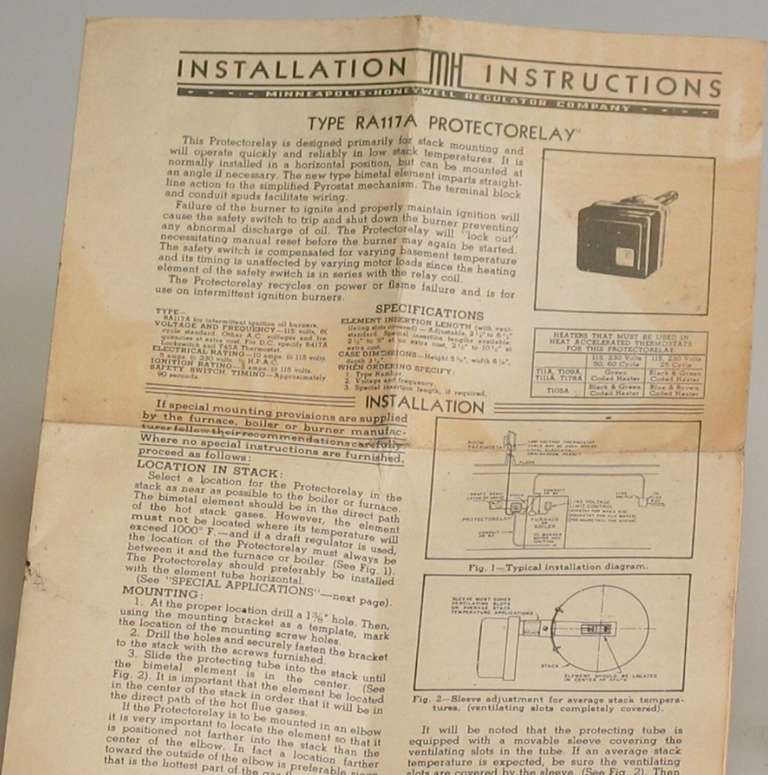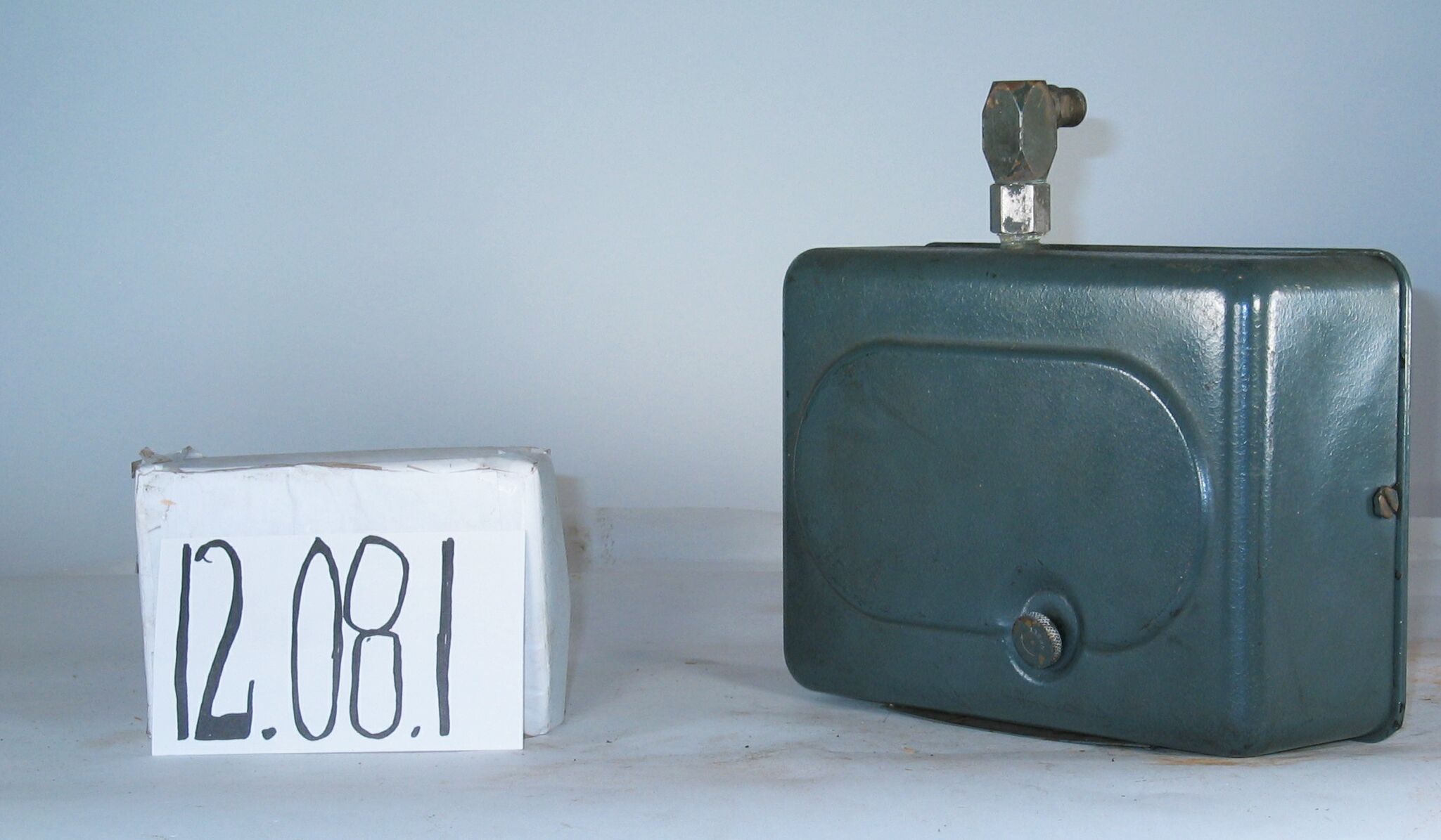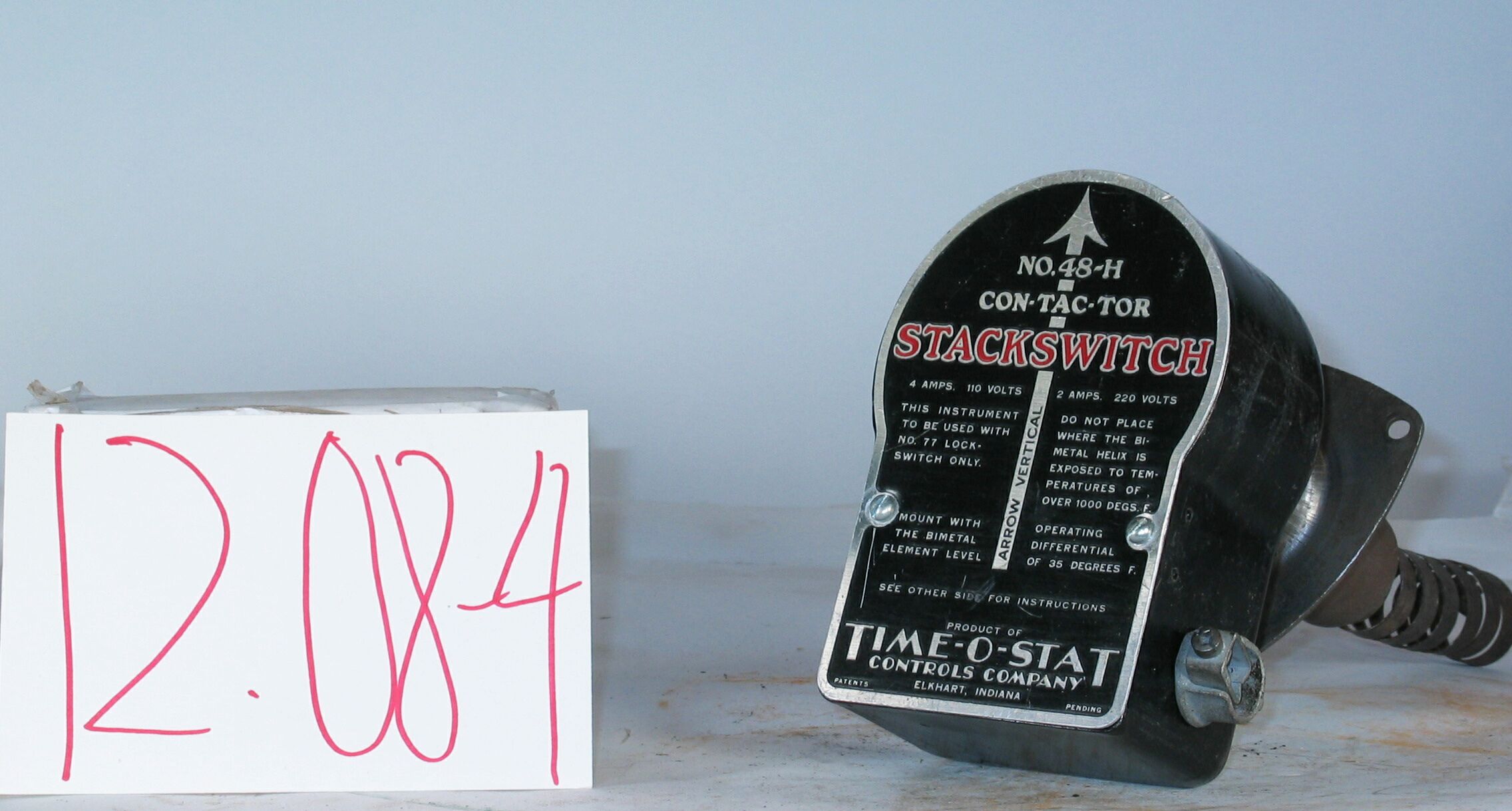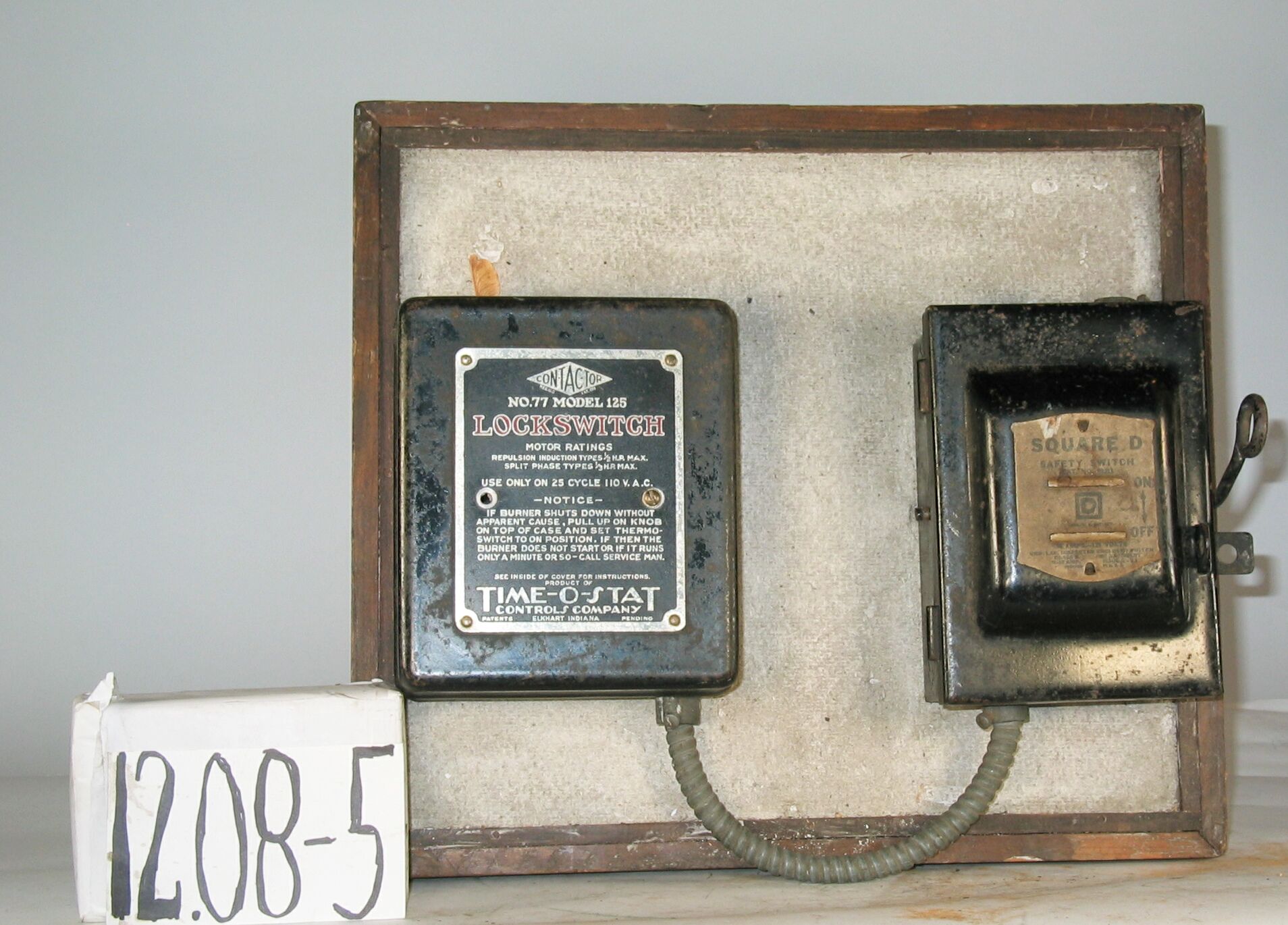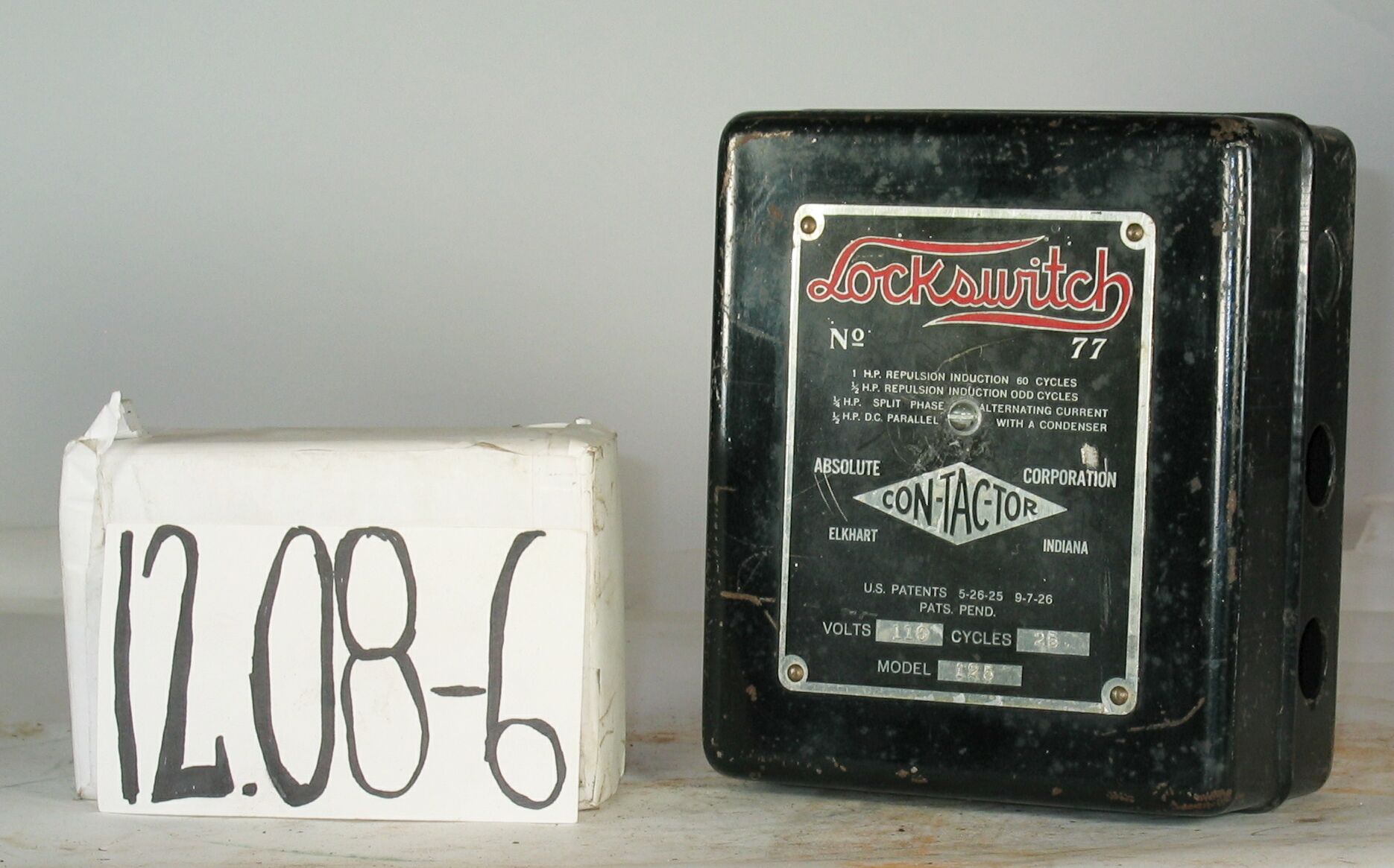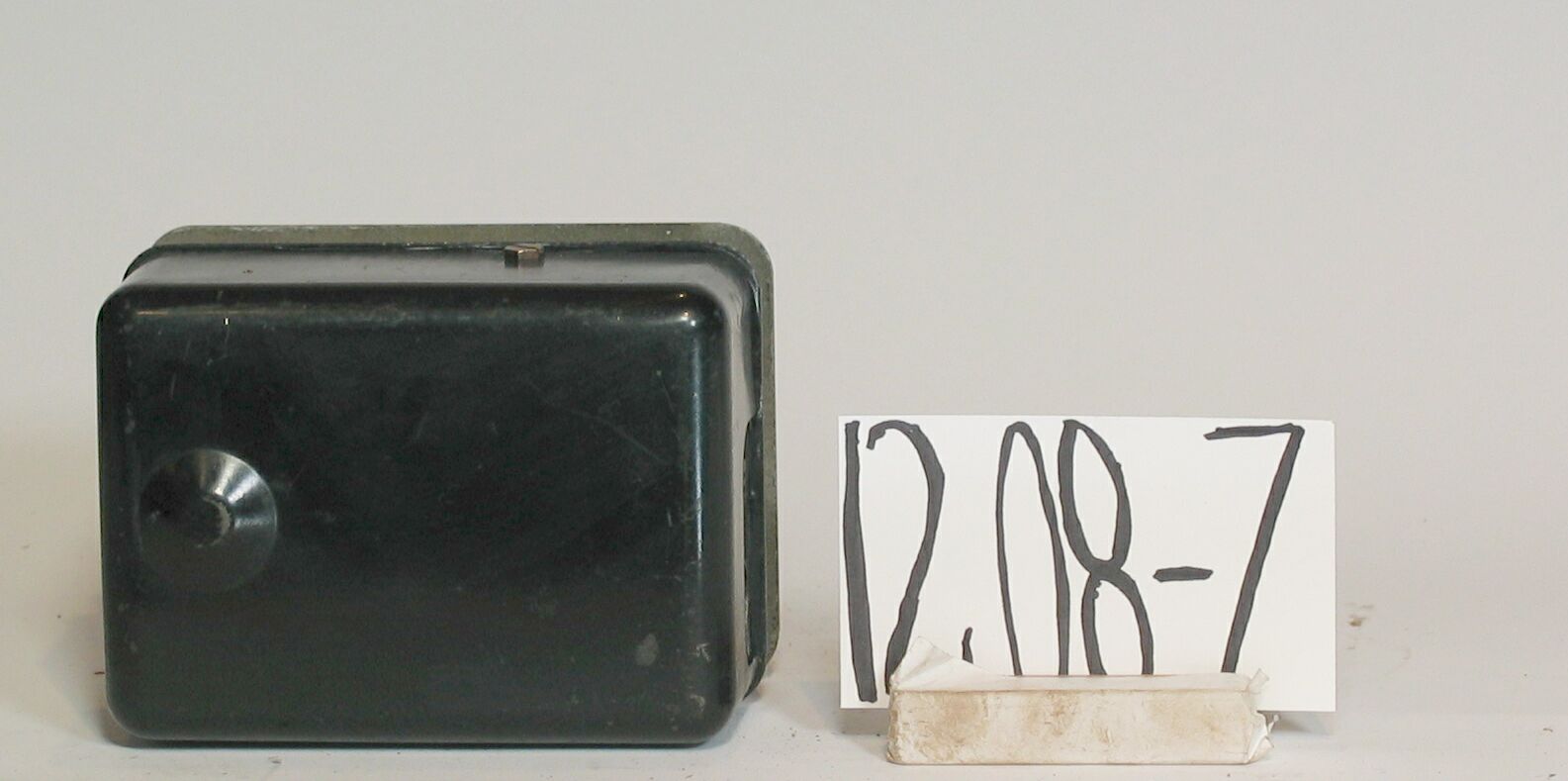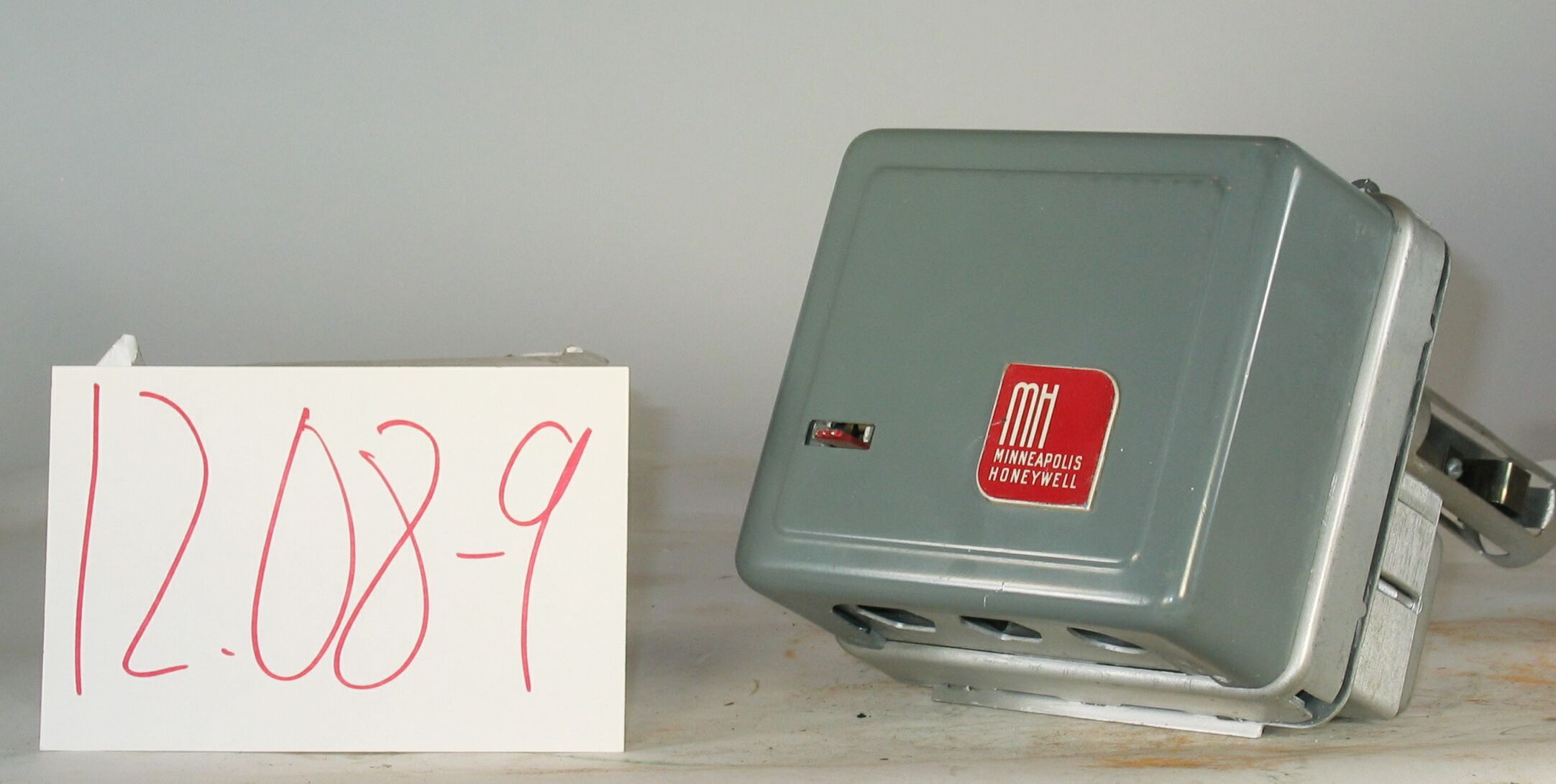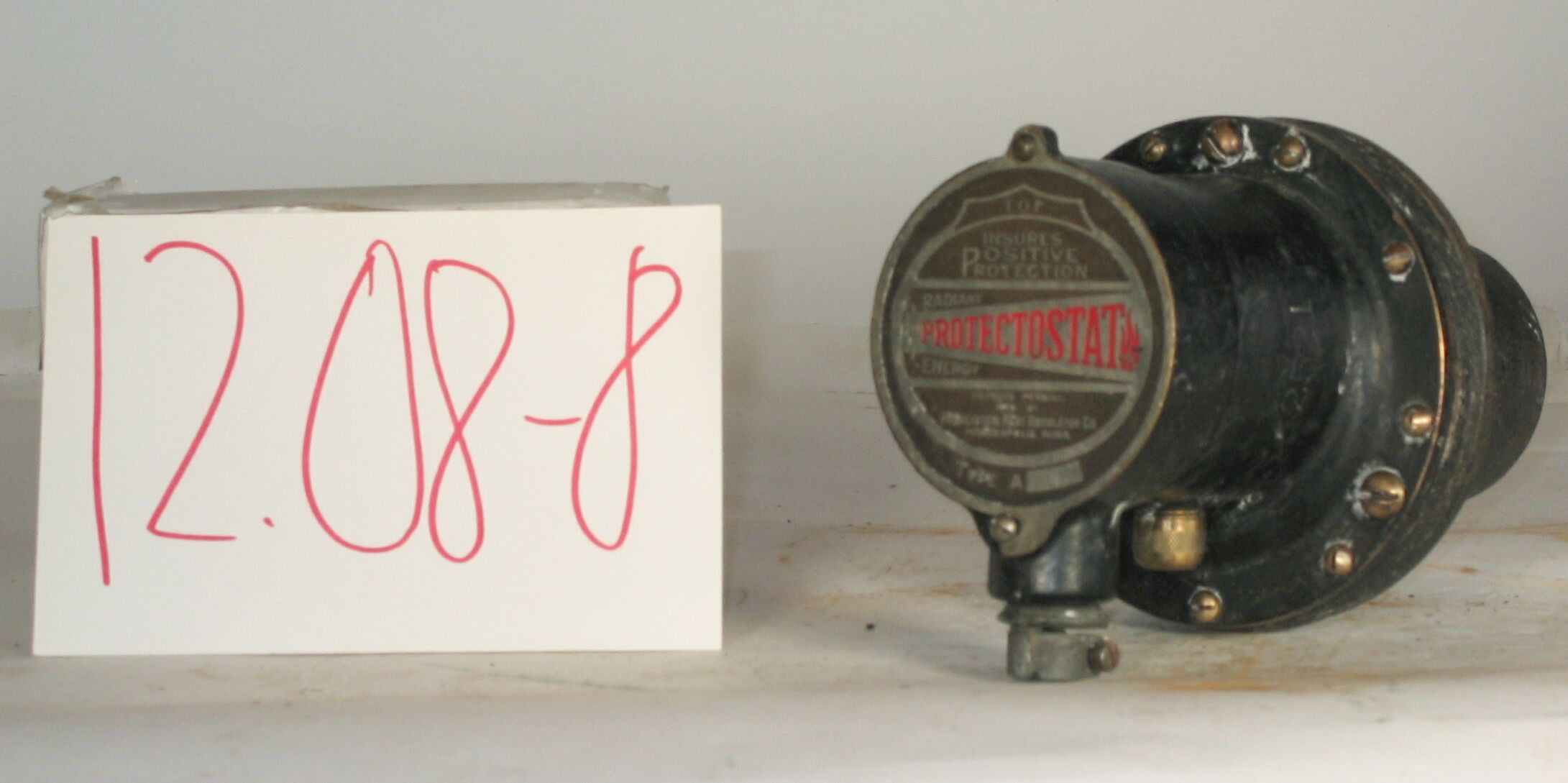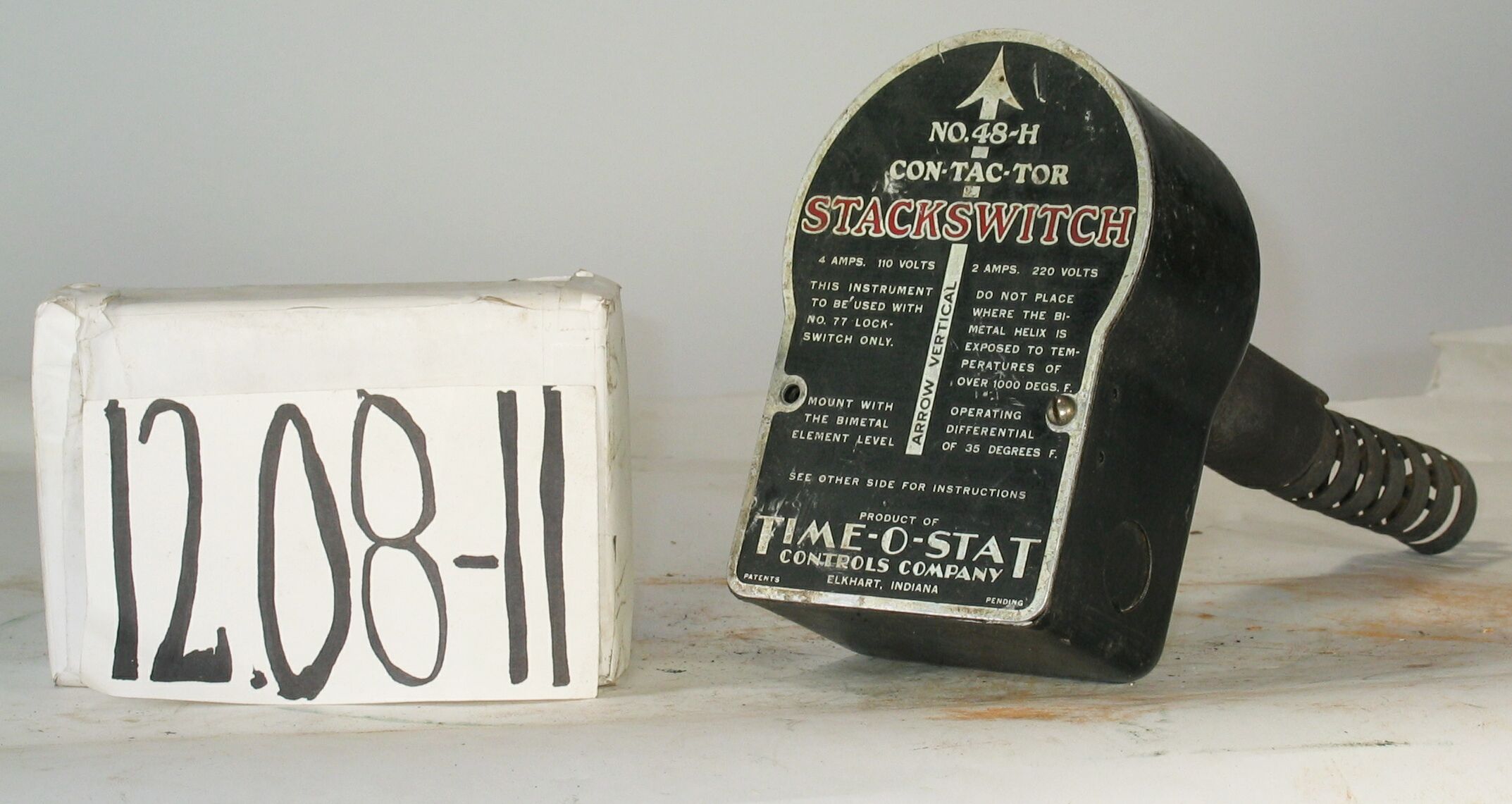12.08-10: Minneapolis Honeywell 1948 Heat Actuated Safety Switch
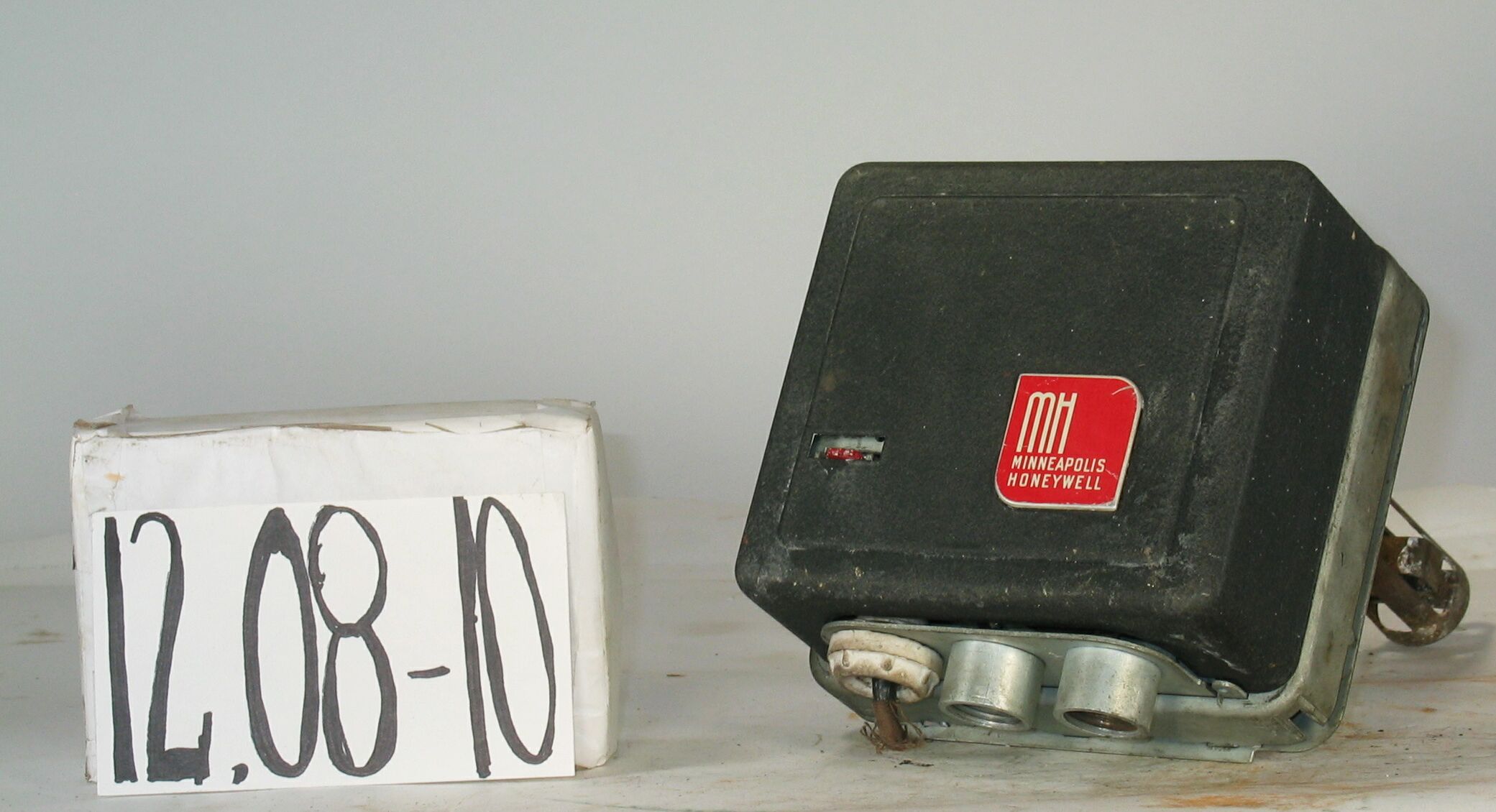
| HHCC Accession No. 2006.111 | HHCC Classification Code: 12.08-10 |
|---|
Description:
An example of innovative, mid 20th century combustion safety control technology that would dominate the field of household automatic oil heating through much of the balance of the century; stack mounted, bimetal heat actuated safety switching, electro-magnetic relay controlled; equipped for intermittent ignition, heat anticipation, 3 wire room thermostat, Type RA117, 60 cycle, Minneapolis Honeywell, Toronto Circa 1948 [See also ID#234]
Group:
12.08 Pressure Atomizing Oil Burner Equipment and Systems - Fuel Flow and Combustion Controls
Make:
Minneapolis Honeywell
Manufacturer:
Minneapolis Honeywell Regulator Co.
Model:
RA117A
Serial No.:
Size:
7 x 11 x 7’ h
Weight:
5 lbs.
Circa:
1948
Rating:
Exhibit, education, and research quality, illustrating the engineering and design of the combustion safety control technology that would dominate the field of household, automatic oil heating for the much of the latter part of the 20th century in Canada.
Patent Date/Number:
Provenance:
From York County (York Region) Ontario, once a rich agricultural hinterlands, attracting early settlement in the last years of the 18th century. Located on the north slopes of the Oak Ridges Moraine, within 20 miles of Toronto, the County would also attract early ex-urban development, to be come a wealthy market place for the emerging household and consumer technologies of the early and mid 20th century.
This artifact was discovered in the 1950’s in the used stock of T. H. Oliver, Refrigeration and Electric Sales and Service, Aurora, Ontario, an early worker in the field of agricultural, industrial and consumer technology.
This particular control was used on a residential heating system in York County [York Region], North of Toronto during the 1930’s.
With original instruction, installation sheet, dated Dec 2, 1944, this control had been held in the stock for replacement purposes, by Howard Oliver, an HVACR contractor in Aurora, north of Toronto.
Type and Design:
Unitary design, Stack mounted, bimetal heat actuated push rod driven contact assembly [Pyrostat] electro-magnetic relay controlled switching for intermittent ignition bimetal safety lock out switch with manual reset Equipped for 3 wire, heat anticipating room thermostat 60 cycle
Construction:
Material:
Special Features:
Cabinet in black ‘ripple’ finish part of the look of the day, based on the metalic coatings technology of the day Handsome corporate monograph in distinctive Minneapolis Honeywell Red Original instruction sheet Original field installed wiring ends Original porcelain cable box connector Original wiring diagram on inside of cover
Accessories:
Capacities:
Performance Characteristics:
Operation:
Control and Regulation:
Targeted Market Segment:
Consumer Acceptance:
Merchandising:
Market Price:
Technological Significance:
Of special significance is the 60 cycle engineering of this controller, built for the Ontario market following frequency standardization, which took place in the closing years of the 1940’s in much of the province. These devices, being electro-magnetic, were frequency sensitive. The much smaller rear mounted transformer used to provide control circuit power tells the story. The 25 cycle equivalent is shown on item ID#234.
With the introduction of new generation of integrated, relatively reliable control systems for household heating in the early 1940’s a new era of mass produced technology had arrived, setting the stage for a new, Canadian mass market. It combined up-dated, bimetal combustion control technology with the three wire, heat anticipating thermostat, - providing comfort, safety and reliability levels unheard of a decade earlier.
By the early 1940’s Minneapolis Honeywell’s unitary designed, combustion controller, the RA117A Protectorelay, had arguably become a kind of standard of achievement for the home, automatic, oil heating industry in much of Canada. The fragile and potentially poisonous mercury bulb switching of earlier combustion controls was replaced here with quiet, reliable, electro-magnetic and bimetal driven snap action contacts, A significant design consideration in the development of unitary, stack-mounted controls was the high ambient temperatures to which they were subjected. High temperature wiring and heat shielding were new design requirements to be dealt with.
These embryonic, electric automated systems were representative of the earliest introduction of complex systems into the Canadian home. See Note #2
Industrial Significance:
The control cabinet cover in black ‘ripple’ finish is representative of the trendy look of the day, based on the new, metallic coatings technology of the period By the mid 1940’s the HVACR industry recognized that a new era in the popularization of automatic home heating equipment was under way. Unitary designed, oil home heating equipment had evolved into a ‘home appliance’, on which many householders would now become heavily dependent. This new, widespread dependency on automatic heating, throughout Canada’s long cold winters, would require the industry to strive for enhanced performance in matters of reliable, maintainable and readily serviceable equipment, with readily obtainable replacement parts. Public expectations for 24 hour emergency service was part of the new world of popular technology that had been created. Honeywell and other manufacturers would respond by providing a line of rebuilt controls for field service people to stock for emergency purposes.
Socio-economic Significance:
A new network of small, Canadian business entrepreneurs would develop in the early post W.W.II years, to meet public needs and those of the industry, ensuring public satisfaction.
Socio-cultural Significance:
The combustion safety control of the 1940’s must be considered as a kind of ‘cultural icon’ in its own right. It symbolized the accessibility and universality of safe, convenient, and reliable automatic home heating for all Canadians. Automatic home heating was no longer to be for the privileged few, the economic elites of Canadian society. It was now available for the most modest homes of the nation. Much like universal health care, all Canadians were to have affordable access to the benefits of safe, reliable, automatic home heating.
Donor:
G. Leslie Oliver, The T. H. Oliver HVACR Collection
HHCC Storage Location:
Tracking:
Bibliographic References:
Installation Instructions, Type RA117A, Protectorelay, minneapolis Honeywell Regulator Co., December 2, 1944
References Cybernetcs and General Systems [Oliver Collection]: Systems Engineering Tools, Harold Chestnut, 1966. Modern Systems Research for the Behavioral Scientist, Walter Buckley, Editor, Aldine, 1968. Systems Behaviour, John Beishon and Geoff Peters, Harper and Row, 1972 Systems Engineering Methods, Harold Chestnut, Wiley, 1977
Notes:
- The Introduction of Popular, Complex Systems into the Canadian Home:
The 1920’s saw the introduction of complex mechanical, electric and electronic systems into the Canadian home and the lives of many Canadians, most of them ill prepared. For the first time the public would experience, as an inherent part of their daily life’s routines, the benefits, as well as all too often the vagaries of systems engineering ‘ then in an embryonic state of development. The level of dependence on such systems, with all their inherent imperfections and attendant risks, would be no more apparent than in the field of automatic home heating.
These systems were at once intimidating, awe inspiring, often the source of feelings of personal ineptitude, as well as of fear for reasons of personal and property safety. Included in the early rush to popular technology systems were the automobile, the household radio and automatic home heating. But the most intimidating was, in many ways the latter, immensely obtrusive, in your face, larger than life, and all around you 24 hours a day, bringing with it a degree of dependency that the householder could not afford to forget in the dead of a Canadian winter. All three of these pieces of technology [the automobile, the household radio and the automatic home heating system], have in common an elaboration of interconnected and interdependent parts on which the integrity and performance of the system would be desperately dependent. For the automatic home heating system these components, each with its own unique integrity and operating characteristics, would include, for example: electric motors, flame sensors, solenoid valves, pressure sensors and actuators, electric ignition transformers, heat detecting devices and thermostats. The advent of such increasingly complex, automated systems [mechanical, electric, and electronic] would, in fact, by the late 1940’s lead to a new specialized field of study, known at that time as ‘Cybernetics’, and thence to the larger field of ‘general systems’. The focus was on coming to understand better the properties and performance of complex, inanimate systems, including their degree of purposefulness, self regulation and self direction setting, as well as their ability to communicate meaningful information within the network of which they were a part. For each component of the system must communicate effectively with others for the system to function safely and satisfactorily. System performance, stability, reliability and maintainability, among other criteria, were at stake. All of these criteria were of fundamental importance in the development of automated heating systems for the Canadian homeowner, and the inventors and manufacturers of the day knew it. [See References, General Systems] For their part the manufacturers of these systems, with their myriad component parts and complexities, would learn from the outset the importance of trained service people in communities across the country, wherever such systems would appear. By the 1940’s training courses were increasingly common, as well as control and systems handbooks and systems trouble shooting guides provided by equipment and systems manufacturers.
